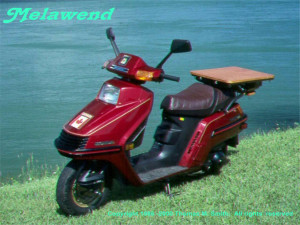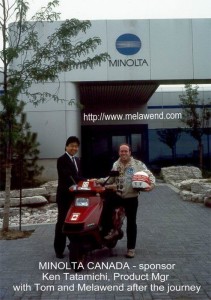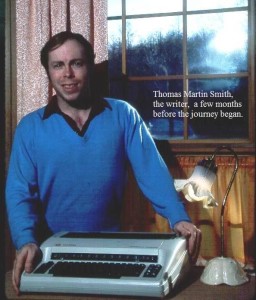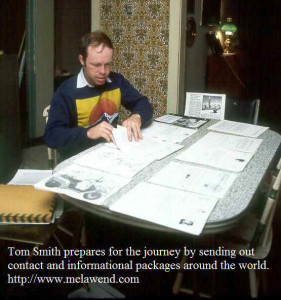Chapter 1: Crossroads
PART I
Trial Run
Chapter 1
CROSSROADS
During that night before the odyssey began, I awoke with my mind exploding, my heart racing. Conflicting feelings were tearing at me: exhilaration, fear, relief. I tried to grasp the source but it flashed by in that twilight zone where your subconscious is caught off guard and escapes at the speed of light to its unknown sanctuary, leaving behind a vapor trail of spent cerebral energy to condense into conscious mind – foggy, fragmented recollections. Something about falling through the ice, Melawend, embassies, bombs exploding, a collision…
I rolled onto my side so I might look at my future. Barely visible in the lamplight that dappled through the maple tree outside Dad’s recreation room window, there on the floor where I had once romped with my toys, I saw several dark lumps. Those were the worldlies I would be taking with me. Silhouetted by the French doors, I saw the black form of Melawend waiting to carry me around the world. The rest of my life seemed to lie before me. I felt a strange sense of relief, as if I could finally take control.
I relaxed. I had been through a lot to get Melawend and those lumps. Now behind me was all the daydreaming, doodling, pacing, researching, planning, networking and physical training. I remembered falling through the ice on Lake Erie last winter near the old pier at Crystal Beach after running the tortuous shove ice along the private beaches of Abino Bay. I smiled to myself as I remembered the two-mile walk home, numb and stiff in frozen clothes, in a walk that might have made Boris Karloff laugh. But I had torn a knee ligament in the breakthrough. That was a major reason I now had, instead of a mountain bicycle, Melawend, a Honda Elite 250cc motorscooter I had named for my daughters, Melanie and Wendy. (Riding her also gave me a feeling of a “mellow wind” and inspired me to be mellow as I would wend my way around the world.) I have my wheels, I thought, and more supplies than I’ll need. Now, there will be no more mailings or phone calls or meetings or city-sore feet chasing after sponsorship.
I lay there content that there would be no more polite rejections.
“Unfortunately, our budgets are extremely tight this year…Your idea has great merit, and I wish you all the best in your efforts to make it come true,” a corporate executive had said in his letter.
Rejections could break you or make you more determined and self-reliant. I had had little choice – I needed help. For now, the emotional riptides of applying for sponsorship, of “going in cold”, were over. I felt stronger for my efforts. Go for it! held personal validity. I had also been greatly encouraged when Minolta Canada, Hiker’s Haven, and Lapp Cycle & Parts had come on board (though Peter Lapp would confess to a Honda representative at lunch after the odyssey, “I thought he was full of hot air!”). Maybe others will help along the way, I thought.
Why am I doing this?
I remembered Ivor Sharp.
“Go around the world,” Ivor had said rather casually in his soft British accent.
Yeah, right.
Wasn’t that a fantasy many people had? But I thought that that advice on growing as a photographer, coming from one of the best, had to be good. He had done it – a four-year trip. I had been in his studio in Toronto and felt honored as I leafed through the large worn portfolio he had produced from that effort. After he had lugged it around to art directors, the doors to his international career opened. He added that more than gaining photographic experience, I would learn how to deal with people.
(PHOTO: Tom’s first montage. Clockwise from upper left, spiral to the center: Neil Diamond in concert in Buffalo, sunrise over Buffalo and the Niagara River, boat on the Niagara River, “Made of the Mist” – Niagara Falls, Canada, horse profile, “Rags” – a Schnauzer), Wendy on swing ride, Dophins at Canada’s Wonderland, International Bridge (train) between Fort Erie, Ontario and Buffalo, New York), Grist Mill at Balls Falls, Ontario, door of grist mill, Ridgeway Public School (Ridgeway, Ontario), the Horsehoe Falls (Niagara Falls) lit at night, Point Abino Lighthouse (Fort Erie, Ontario), boat on Lake Erie, Brock University (St. Catharines, Ontario, skyline of Toronto, Thomas Martin Smith self-portrait)
I thought of generous Jimmy Bedford, the retired chairman and professor emeritus of the Department of Journalism and Creative Writing of the University of Alaska. I had been referred to him by Robert Gilka, the chief of photography for National Geographic. Truly, Jimmy was unretiring, the handlebar mustachioed adventurer, now travel columnist for the Fairbanks Daily News Miner (“Journeys on the Planet Earth” – weekly, full-page).
Jimmy had worked his way around the world 28 years earlier and had written a book about his journey – Around the World on a Nickel (published in India and long-since out of print). And he was still making junkets here and there. In response to my query, he sent reams of travel articles he had written together with a long letter about his experiences. He offered good advice such as tying up with a newspaper to gain access to events; shooting photographs in black and white as well as color; and, indirectly, that my journey, like his, might take longer than expected. It was a mother lode of seat-of-the-pants wisdom.
During his 18-month world journey, Jimmy covered 25,000 miles between Italy and Ceylon (now Sri Lanka) on a motorscooter (a Vespa). He and pointed out the obvious advantages of a motorscooter over a bicycle (to which I was still committed). He added that either vehicle could be borrowed, rented or bought along the way.
“Being committed to a single bicycle the whole way might be a real burden,” he said.
But for me, there would be a sense of completeness, of a commitment fulfilled in taking something, a “burden” as it were, full cycle – I was determined to take Melawend all the way.
As I lay on the cot, time seemed suspended – the present was an uneasy resting-place between the past and the future. I was alone in my life, again, and had been so for some time. I was tired of those things that went along with the acceptance of a lesser life. I had said “If I had…” and “Maybe someday…” too many times. Life’s unseen, unforgiving clock was always ticking away. Two years earlier, I left a career as a real estate title searcher for a law firm, a responsible but dead-end job, I felt, and… Oh, what the hell – I’d had a wife and family (two beautiful daughters), a decent job, a heritage home… and now I was divorced, lonely, unemployed and broke. I no longer had a home of my own and, until last winter, I had no true direction for my life. I was pretty well screwed up, or perhaps I was unscrewed – you know, falling apart. (I had also wasted time making up metaphors for life instead of living it).
I did have dreams of a better life. I wanted to be a writer. And I had those altruistic feelings for the world – desires for world peace; restoration of the environment; an end to racism, poverty, ignorance and disease; a firm belief that the magnificent but tattered tapestry of humankind was still bound by common threads: love of live and the need for peace around and within us – all of that. But I kept those feelings mostly to myself because if you were a loner and said much about them, they might have seemed like empty platitudes. Still, I had wanted to do something about those feelings.
It was the Spring of 1986, a dawn of great change – the world seemed poised for peace. U.S. President Ronald Reagan and Soviet leader Mikhail Gorbachev were beginning to shake hands more than fists and their recent photo-op smiles seemed genuine. In Geneva last November, they warmly toasted better relations over a cheap bottle of French champagne after George Schultz and Eduard Sevardnadze, their respective foreign ministers, had signed a cultural and scientific exchange agreement. On New Year’s Day, the two leaders shocked each other’s citizens by simultaneously appearing on millions of TV sets and addressing each other’s nations. Reagan called for joint U.S. – Soviet efforts to make 1986 “a year of peace” and Gorbachev wished American families “good health, peace and happiness.”
I had been inspired by people who were out there trying to make the world a better place through their specific projects – including British musician Bob Geldof and his “Aid” concerts, and my fellow countryman Rick Hansen, in the mold of Terry Fox, already in the Far East, over a year into his Man in Motion World Tour in a wheelchair to promote spinal cord research. There were many benevolent organizations including the Red Cross, the United Way, Amnesty International, the World Wildlife Fund, UNICEF and all the other United Nations aid agencies – all doing their thing to make this a better world.
Just last Friday, Prince Charles and Diana, Princess of Wales, opened Expo ’86 in Vancouver, Canada. Expo’s theme – “World in Motion, World in Touch” – seemed an appropriate celebration and inspiration for world travel – despite that terrorism and radioactive clouds from Chernobyl were keeping tourists away from Europe, where I would soon be heading.
As I lay there in the dim light, I thought, I’m no activist. And maybe this enterprise of mine is too broad, vague and personal. But I had convinced myself that perhaps by getting out of myself, getting out there, getting focused, seeing as much of the world as I could, meeting people on their own ground (were people truly the same wherever you went?), promote a little international friendship, and then come back and tell about it – write this book – maybe some readers would look at the world, and themselves, more positively. And perhaps I would grow in the exchange. But now, only hours before my departure, I wondered if going on good intentions would be good enough.
Somewhere in those dark lumps was the ambassador-in-blue-jeans paraphernalia I had assembled, which included laminated open letters of greeting from Girve Fretz, our federal Member of Parliament, and Mayor Heinz Hummel, Mayor of Fort Erie (Ridgeway, my hometown, is part of Greater Fort Erie). I also had such a letter from Lynda Sykes, Tourism Manager for our Chamber of Commerce, offering an exchange of information (brochures, commerce reports, artifacts, whatever) with communities I would visit. There were town and national flag pins, pens, stickers, postcards, desk flags – little diplomatic giveaways.
It made me cringe to see myself so totally out of character, scooting to municipal and national offices around the world to see any official who would see this rather odd, self-appointed diplomat and welcome this exchange, this gesture of friendship. But I believed in the concept and had given myself a year to do it. For better or worse, Cycle for Life – World Odyssey was ready for the road.
But was I ready? I thought, Me, a shy loner – can I really do this? Will I be understood and accepted or ignored or just envied? Should I wait another year – for more studies, training, financing, focus…? And I’ve never ridden a motorcycle! In fact, I had loathed the image I held of a “biker”: maliciously vagrant, obscene and dangerous. I had considered motorcycling to be extremely reckless and hazardous. I might die doing this!
For some time, I lay there watching images of my life flicker in my mind like a silent movie: times I wanted to forget, and times I wanted to hang on to. I knew I needed change – self-improvement, new ideas, and new perspectives on life and love. I felt that travel, real travel as opposed to banal, encapsulated tourism, could transform you and give you a foundation for future endeavors.
And like the determined character in Richard Bach’s Jonathan Livingston Seagull, I wanted to overcome limitations and truly learn how to fly, as it were. I believed that the spirit of exploration and of individuality lived in everyone, whether it was engaged, ignored or repressed. I felt that before a world of “No’s” and necessary precautions were imposed on us, every child spontaneously expressed that spirit in some way. I remembered being told by my mother how, at the age of three, I had taken off on a friend’s tricycle, and how the police and fifty townspeople searched for me, and how I was found by one of my uncles, peddling happily by myself along a road at the north end of town. I thought that perhaps part of this current enterprise was rooted in that early effort.
I was a small-town Canadian boy, silently proud of my country’s multicultural heritage, beauty and peaceful ways, and inactively ashamed and infuriated by our domestic bilingual bickering and by our neglect of our aboriginal people. I had been fairly comfortable in my relative isolation from Canada’s and the world’s problems – I did care, but I had a remote control and locks on my doors. There was real comfort and security in my owner-built cocoon.
I also considered myself a North American, having been raised in a town next door to the USA at its busiest border crossing. I had grown up mostly on America’s vast and invasive media. I had poured over the marvels in National Geographic, coverage in Time, portrayals in Life, the t&a and interviews in Playboy and what I often considered the warped inquiring mind of the National Enquirer. I’d been moved by works of great dead American writers such as Mark Twain, Thomas Wolfe and Ernest Hemingway. (Could a writer really beat dead men at what they had done, or merely take attempt their undying challenge? Who, for example, had yet truly beaten Hemingway?)
As a kid, I dove through obstacles like school and dinner and chores so that I could watch TV: The Bullwinkle Show (with Boris and Natasha and with Dudley Doright to the rescue!), The Flintstones (“eeyabba-dabba-do!”), The Jetsons (“Gee, Mr. Spacely…”), and The Three Stooges (“Take that!” BONG! “Nyuh, nyuh, nyuh.”), and I Love Lucy (didn’t everyone?).
I grew older and thrived on All In The Family with its realistic ethnic and domestic absurdities; the sock-it-to-me shtick of Rowan & Martin’s Laugh-In (“You bet your sweet bippy!”); The Ed Sullivan Show (“We have a really big shew for you tonight.”); The Tonight Show Starring Johnny Carson (when he hosted it); and the deadly cross-examinations of Perry Mason.
I could rest my case there but there was also the timeless anti-war wit of M.A.S.H.; Bob Hope’s one-liners for all timers (Thanks for the memories, Bob!); Red Skelton’s unforgettable characters (…and my God bless you too, Red.); Eddie Murphy’s bone-splitting charm and Robin Williams’ ingenious, insane improvs, and so many and so much more, including the game shows: Beat the Clock; What’s My Line?; Let’s Make A Deal; Jeopardy; and Truth or Consequences – which sounded like scenarios of the U.S. government. I had seen the parody of U.S. presidents: Kennedy’s charisma, Johnson’s jowls, Nixon’s no-no’s, Carter’s creamy smile and Reagan’s roar. And what ever happened to Martin Luther King’s dream? There had also been too many televised funerals.
Then there were the singers so familiar that you referred to them by their first names: Neil, Barbra, Michael, Bette, Kenny and Dolly.
Singers and exquisite instrumentals – for this journey, I had my cassettes of selected music to cheer me up.
Like untold millions the world over, I had been awed by fantastic movies – the biblical epics, the family sagas and the immortal characters such as Mickey Mouse, E.T., and Indiana Jones (Will I be seen as a would-be Indy?) And those soundtrack composers and those masters of direction – I wondered what my life would have been like without the genius the likes of Maurice Jarre, Henry Mancini, Quincy Jones and John Williams, and of Walt Disney, Cecil B. DeMille, David Lean, John Huston, and Steven Spielberg.
(I’m sorry I can’t name you all – I would never get this story written!)
And after supper there were the big three network newscasts – ABC, NBC and CBS – growing wiser with Walter Cronkite saying, “And that’s the way it is…” Then there were Barbara Walter’s Specials and hours and hours of 60 Minutes. And wasn’t it last night that I heard Peter Jennings say for the umpteenth time: “In the Middle East today…”
(I’ll cut it here, dear reader, for that reverie is perhaps becoming tedious – maybe like listening to reruns of Academy Award recipients. Suffice it to say I felt I had been profoundly educated and influenced by America.)
I loved Canada but I had seen the world largely through America’s proud, sometimes arrogant but always self-critical eyes. What I had seen had both amazed and frightened me. I thought, I must go out and see for myself. I can and will do it! I further emboldened myself by internalizing the words of Captain James Kirk: that my mission was “…to seek out new life and new civilizations, to boldly go where no man has gone before.” – at least where I had not gone before, here on this revered and abused Earth.
I sighed and drew the cover up. I was now publicly committed to the enterprise I had created – the Times-Review, our local paper, had recently run the story of my impending journey and stated that I would be writing stories for its readers from the road. There had been no fanfare – I was glad of that – just private conversations with the people involved. Now I was on my own…on my own…
Somewhere in my fading thoughts, I fell asleep.
CANADA ~~ ENGLAND ~~ WALES ~~ SCOTLAND ~~ NORWAY ~~ SWEDEN ~~ DENMARK ~~ THE NETHERLANDS ~~ BELGIUM ~~ LUXEMBOURG ~~ GERMANY ~~ LIECHTENSTEIN ~~ AUSTRIA ~~ SWITZERLAND ~~ FRANCE ~~ SPAIN ~~ MONACO ~~ ITALY ~~ THE VATICAN ~~ GREECE ~~ EGYPT ~~ SUDAN ~~ KENYA ~~ INDIA ~~ NEPAL ~~ SINGAPORE ~~ MALAYSIA ~~ JAPAN ~~ HAWAII ~~ USA ~~ RETURN
MELAWEND – My Amazing Honda Elite 250 Motorscooter
Helpful Quotes & Odyssey Photos by Tom
NEWS ~ About ITLR ~ About Tom ~ Chapters ~ Galleries ~ FAQ ~ Contact ~ For YOU!
Chapter 1: Crossroads
Chapter 23: Sojourn in Greece
Chapter 24: The Ups and Downs of Egypt
IN THE LONG RUN: Stories Written From The Road
Christmas in Greece – lively, lonely…



![Thomas_Martin_Smihs_early_photo_montage[1]](http://www.melawend.com/wp-content/uploads/2014/06/Thomas_Martin_Smihs_early_photo_montage1-300x256.jpg)



Recent Comments